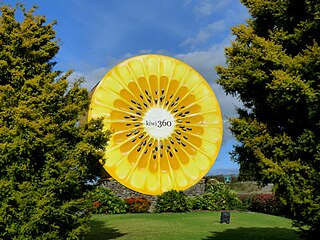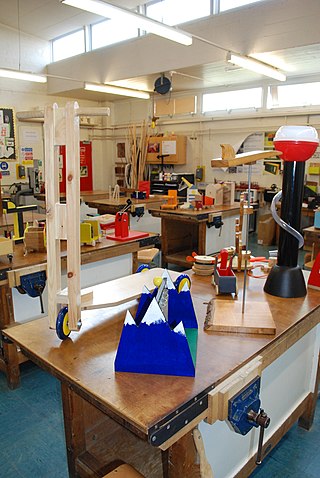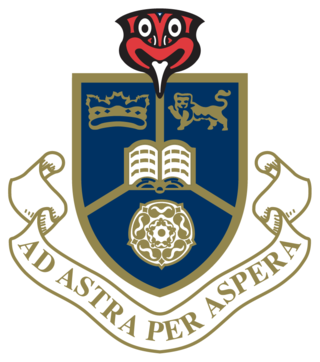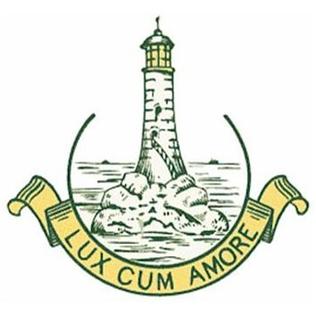Science education is the teaching and learning of science to school children, college students, or adults within the general public. The field of science education includes work in science content, science process, some social science, and some teaching pedagogy. The standards for science education provide expectations for the development of understanding for students through the entire course of their K-12 education and beyond. The traditional subjects included in the standards are physical, life, earth, space, and human sciences.
The education system in New Zealand implements a three-tier model which includes primary and intermediate schools, followed by secondary schools and by tertiary education at universities and polytechnics. The academic year in New Zealand varies between institutions, but generally runs from early February until mid-December for primary schools, late January to late November or early December for secondary schools and polytechnics, and from late February until mid-November for universities.

In education, a curriculum is broadly defined as the totality of student experiences that occur in the educational process. The term often refers specifically to a planned sequence of instruction, or to a view of the student's experiences in terms of the educator's or school's instructional goals. A curriculum may incorporate the planned interaction of pupils with instructional content, materials, resources, and processes for evaluating the attainment of educational objectives. Curricula are split into several categories: the explicit, the implicit, the excluded, and the extracurricular.

Sir Āpirana Turupa Ngata was a prominent New Zealand statesman. He has often been described as the foremost Māori politician to have served in parliament in the mid-20th century, and is also known for his work in promoting and protecting Māori culture and language. His legacy is one of the most prominent of any New Zealand leader in the 20th century, and is commemorated by his depiction on the fifty dollar note.
Tenth grade is the tenth year of formal or compulsory education. It is typically the second year of high school. In many parts of the world, students in tenth grade are usually 15 or 16 years of age.
Eleventh grade is the eleventh year of formal or compulsory education. It is typically the third year of high school. Students in eleventh grade are usually 16–17 years of age.

Te Aute College is a school in the Hawke's Bay region of New Zealand. It opened in 1854 with twelve pupils under Samuel Williams, an Anglican missionary, and nephew and son-in-law of Bishop William Williams. It has a strong Māori character.

Te Puke is a town located 18 kilometres southeast of Tauranga in the Western Bay of Plenty of New Zealand. It is particularly well known for the cultivation of Kiwifruit.

Design and Technology (D&T) is a school subject taught in England to pupils in primary and secondary schools. It first appeared as a titled subject in the first National Curriculum for England in 1990. It has undergone several reviews when the whole National Curriculum has been reviewed, the most recent in 2013.
New Zealand's Top 100 History Makers was a weekly television programme first shown on Prime Television New Zealand on 6 October 2005. 430 notable New Zealanders were ranked by a panel to determine the 100 most influential in New Zealand history. There were six episodes to present the list, and a final (seventh) episode, screened live on 17 November 2005, showed the rankings of the top ten of these people as a result of votes collected from the public via text and internet..

The New York State Education Department (NYSED) is the department of the New York state government responsible for the supervision for all public schools in New York and all standardized testing, as well as the production and administration of state tests and Regents Examinations. In addition, the State Education Department oversees higher education, cultural institutions such as museums and libraries, vocational rehabilitation, and the licensing of numerous professions. It is headed by the Board of Regents of the University of the State of New York (USNY) and administered by the Commissioner of Education.

Ao Tawhiti or Ao Tawhiti Unlimited Discovery is a state area school in Christchurch, New Zealand. It was established by the merging of two separate Christchurch inner city schools; the primary school Discovery 1 and the secondary school Unlimited Paenga Tawhiti.

Tauranga Boys' College is a state secondary school for boys, located on the edge of the downtown area of Tauranga, New Zealand. The school was founded in 1946 as Tauranga College, before overcrowding saw the school become single-sex in 1958. The school has a roll of 1,764 students from years 9 to 13 as of February 2024. In 2019 Tauranga Boys' gained the most scholarships in the Bay of Plenty region with 31 scholarships and 6 outstanding scholarships.

Upper Hutt College is a state co-educational secondary school located in Trentham in the city of Upper Hutt, New Zealand. The school opened in 1962 as the city's second state secondary school, supplementing Heretaunga College in Wallaceville. As of February 2024, the school has a roll of 1,163 students from years 9 to 13.

Wainuiomata High School, a state co-educational secondary school, operates in Wainuiomata, a suburb of Lower Hutt in New Zealand. The school was founded in January 2002 from the merger of Wainuiomata College and Parkway College. A total of 655 students from Years 9 to 13 attended the school as of February 2024.

Rotorua Boys' High School (RBHS) is a state school educating boys from Year 9 to Year 13. It is situated just outside the Rotorua CBD at the intersection of Old Taupo Road and Pukuatua Street in Rotorua, New Zealand. The school is governed by an elected School Board, of which the Principal is ex officio a member under guidelines laid down by the New Zealand Ministry of Education. With Māori enrolment exceeding 75% of the school’s intake, the largest per capita in New Zealand, RBHS has been a longstanding recipient of funding from its Ngāti Whakaue endowment that assisted the construction of the school’s 104-bed hostel, and the purchase of a computer laboratory. RBHS is noted for its performance in sport, with 4 Olympians among its notable alumni, and for having won the Prime Minister of New Zealand Supreme Award for Excellence in Education and the Excellence in Leading Award, making it the top school in the country for 2019. Its current principal, Chris Grinter, is the longest serving in the school's history, and in 2022, he received a New Zealand Order of Merit for services to education and Māori.

Ōpōtiki College is a state secondary school located in Ōpōtiki, in the Bay of Plenty, North Island, New Zealand.

Paraire "Friday" Henare Tomoana was a Māori political leader, journalist, historian, sportsman, and lyricist of the Ngāti Kahungunu and Ngāi Te Whatu-i-Apiti tribes. Born either in Waipatu or Pakowhai near Hastings, he was the son of Henare Tomoana, the principal chief of the Heretaunga region and Member of Parliament for the Eastern Māori electorate. He was educated at Te Aute College and was a member of the Young Māori Party, an association of alumni from the college that dominated the Māori political landscape in the early 20th century.

Rangiora High School is a state co-educational secondary school located in Rangiora, New Zealand. Established in 1881 by an act of parliament and opened in 1884, the school has a roll of 1,652 students from years 9 to 13 as of February 2024, making it the fifth-biggest school in the South Island.

Specialist schools, also known as specialised schools or specialized schools, are schools which specialise in a certain area or field of curriculum. In some countries, for example New Zealand, the term is used exclusively for schools specialising in special needs education, which are typically known as special schools.















